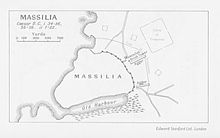Siege of Massilia
| Siege of Massilia | |||||||
|---|---|---|---|---|---|---|---|
| Part of the Caesar's Civil War | |||||||
 Map of the siege |
|||||||
|
|||||||
| Belligerents | |||||||
| Massilia and Optimates | Populares | ||||||
| Commanders and leaders | |||||||
| Lucius Domitius Ahenobarbus |
Gaius Julius Caesar Decimus Junius Brutus Albinus Gaius Trebonius |
||||||
| Strength | |||||||
| 8,000 | 15,000 - 3 Roman legions (XVII, XVIII, and XIX) | ||||||
| Casualties and losses | |||||||
| 4,000 | 1,100 | ||||||
The Siege and naval Battle of Massilia was an episode of Caesar's civil war, fought in 49 BC.
Lucius Domitius Ahenobarbus had become proconsul of Gaul and was sent to gain control of Massilia (modern Marseille) in order to oppose Caesar. As Caesar marched to Hispania (en route to the Battle of Ilerda), the Massiliots closed their gates to him, having allied with Ahenobarbus and the Optimates. Roused by their hostile actions, he commenced a siege against Massilia, leaving the newly raised 17th, 18th, and 19th legions to conduct the siege. These were the same legions that would be wiped out at Teutoburg Forest 58 years later. He also placed Decimus Junius Brutus Albinus in charge of his fleet there.
After the siege had begun, Ahenobarbus arrived in Massilia to defend it against the Caesarian forces. In late June, Caesar's ships, although they were less skillfully built than those of the Massiliots and outnumbered, were victorious in the ensuing naval battle.
Gaius Trebonius, Caesar's legatus, conducted the siege using a variety of siege machines including siege towers, a siege-ramp, and a "testudo-ram". Gaius Scribonius Curio, careless in adequately guarding the Sicilian Straits, allowed Lucius Nasidius to bring more ships to the aid of Ahenobarbus. He fought a second naval battle with Decimus Brutus in early September, but withdrew defeated and sailed for Hispania.
Caesar built a stationary tower, 30 ft. square and six stories in height, under the very walls of the city and in face of a rain of missiles from its engines. The walls of the tower were of brickwork 5 ft. thick. When the lowest storey was built it was covered with a solid fireproof roof which was not secured to the walls but rested upon them like a lid. The eaves projected considerably, and from them screens were hung on all sides, covering all the walls. By means of screws the whole canopy, roof and screens, was now raised to the height of one storiey and the workmen proceeded to build the walls of that storiey under its protection. This process was repeated in the same manner until the full height of the tower was attained.
...
Wikipedia
